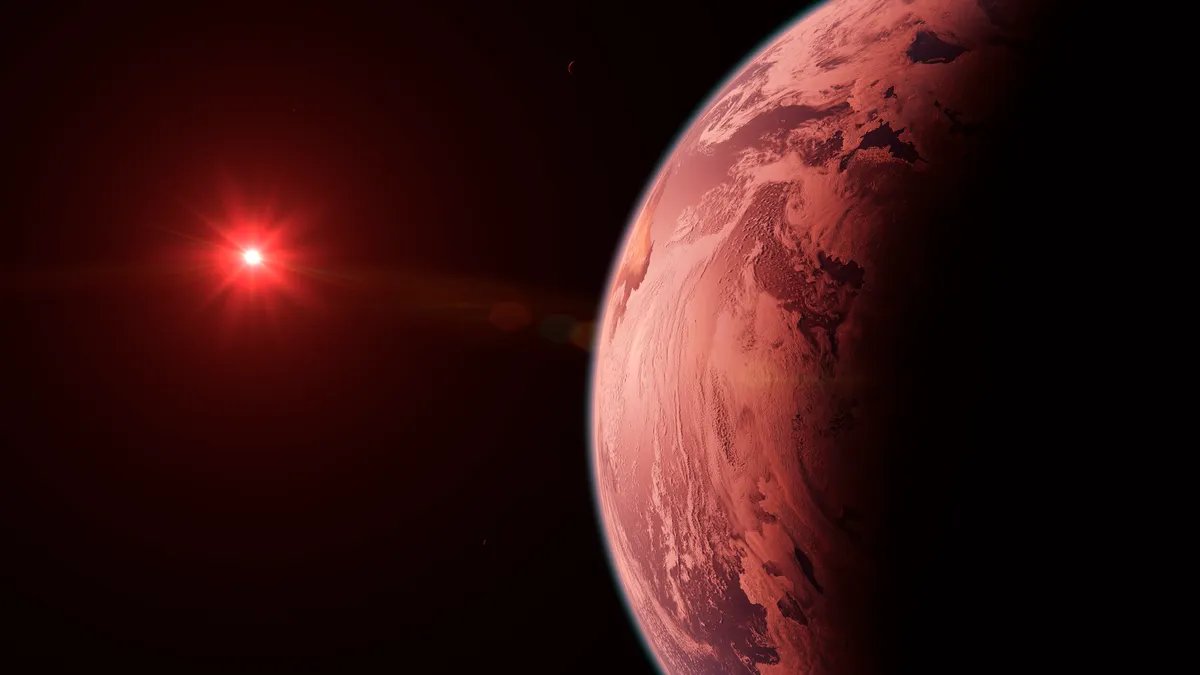Since the first exoplanets were discovered in the mid '90s, the field of hunting for planets beyond our Solar System has exploded.
It seems like every week now, there's a new discovery, be that of super Earths and mini Neptunes, or hot Jupiters orbiting scorchingly close to their host stars.
The field of exoplanet study also concerns the field of search for life beyond Earth.
Studying exoplanets' atmospheres can tell us a lot about what that planet might be like, including whether it hosts life.

Certain chemicals in an exoplanet's atmosphere would indicate the presence of life on its surface: these are known as biosignatures.
We know that life on Earth creates waste gases that unbalance our atmosphere. Now astronomers are seeking similarly off-kilter worlds in the hunt for alien life.
Jayne Birkby is an associate professor of exoplanetary science at the University of Oxford.
We spoke to her to find out more about her research into searching for life in the atmospheres of planets orbiting stars beyond our Sun.

How do you use exoplanet atmospheres to look for life?
Life impacts our atmosphere on Earth. The amount of oxygen in our atmosphere is in a disequilibrium state; there’s something constantly replenishing it in our atmosphere – and that’s life.
If all life on Earth was to suddenly disappear, the oxygen in our atmosphere would disappear.
The idea is that if we can see the same signature of disequilibrium elsewhere, that starts to become a signature that maybe life is causing that.
What molecules are you looking for?
There are four main molecules that we focus on when talking about Earth-like life: oxygen, water, carbon dioxide and methane.
There are other less abundant things out there that might signal life as well, molecules that can only be made by life.
But the former are the easiest things for us to look for.
It’s the abundance that matters – on Earth, we have 21% oxygen.
The molecule itself also makes it easier to observe, as it has a strong absorption line in its spectrum, which makes it easier to detect.

How do you observe exoplanet atmospheres?
As a planet orbits, it causes its star to wobble back and forth because of the gravitational pull of that star.
The star is wobbling at a few centimetres or metres per second. Meanwhile, the planet is whizzing around at kilometres per second.
That means if you were to observe the spectra of the planet you would see it Doppler-shifting back and forth, while the star by comparison would look almost stationary.
Remove everything that isn’t moving in wavelength over time and what you’re left with – buried in a lot of noise – is a spectrum.
If we do this at a high resolution, there are many lines, so it’s a very robust detection.
What kind of planets do you observe?
The important thing about this technique is that it works on non-transiting exoplanets. That means
it makes the nearest planets accessible.
With our current facilities, telescopes in the eight-to-10-metre class, we’re looking in detail at hot Jupiters.
We’re starting to push towards the mini-Neptunes – we really don’t know much about these planets at all.
About 75 planets have been observed at high spectral resolution, finding molecules and atomic species in the atmospheres.
For the very specific method of high resolution with cross correlation that I do, the number is more like 50–60 planets.

How common are the molecules that you’re looking for?
We see water pretty much everywhere. We find carbon monoxide in a lot of hot Jupiters too.
This is all expected from standard equilibrium chemistry.
Carbon dioxide has only been confidently seen with low-resolution spectra from space.
Methane is tentatively seen using the high-resolution method in hot Jupiters, but has been seen at lower resolution with the James Webb Space Telescope for a sub-Neptune planet.
Oxygen has not been detected. None of these suggests any evidence of life.
That would be more for the rocky planets, which we haven’t looked at yet at high resolution.

How could you examine rocky worlds?
We need the Extremely Large Telescope, due to start operations in 2028. It will have a 39-metre-diameter mirror – we need that big ‘light bucket’.
The goal is to make a census of rocky planets and see how many of them are like Earth.
Maybe they’re all like Venus – really hot, with a sulphuric atmosphere that’s inhospitable to life.
Or maybe they’re like Mars, just arid deserts.
Water and methane, in particular, have quite complex spectra that make them harder to distinguish, so the fact that we can find molecules in hot gas giant planets is good news for searching for biosignatures on rocky worlds.
It means when we look at rocky planets where we might hope to find life and where these molecules could be biosignatures, we know that our methods will work.
This interview appeared in the April 2024 issue of BBC Sky at Night Magazine

